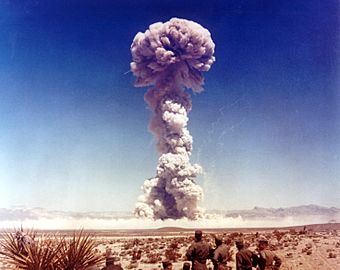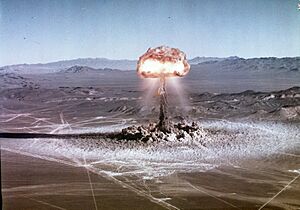Operation Buster–Jangle facts for kids
Quick facts for kids Operation Buster–Jangle |
|
|---|---|

Buster–Jangle Dog
|
|
| Information | |
| Country | United States |
| Test site | NTS, Areas 1–4, 6–10, Yucca Flat |
| Period | 1951 |
| Number of tests | 7 |
| Test type | cratering, dry surface, free air drop, tower |
| Max. yield | 31 kilotonnes of TNT (130 TJ) |
| Navigation | |
| Previous test series | Operation Greenhouse |
| Next test series | Operation Tumbler–Snapper |
Operation Buster–Jangle was a group of seven nuclear weapon tests done by the United States in late 1951. These tests happened at the Nevada Test Site. Six of the tests exploded in the air, and one created a crater in the ground.
This operation was special because it was the first time the U.S. military (who ran "Operation Buster") worked together with scientists from Los Alamos National Laboratories (who ran "Operation Jangle"). About 6,500 soldiers took part in exercises called "Operation Desert Rock" during the tests. The last two tests, part of "Operation Jangle," looked at how much damage low-power nuclear devices could do to the ground. This series of tests came after Operation Greenhouse and before Operation Tumbler–Snapper.
Soldiers and the Tests
During the "Dog" test of Operation Buster–Jangle, four different U.S. Army groups took part in combat practice. This happened right after a nuclear weapon was set off. The soldiers involved were from:
- The 1st Battalion 188th Airborne Infantry Regiment of the 11th Airborne Division
- The 3rd Medical Platoon 188th Airborne Medical Company
- A Platoon from Company A 127th Engineer Battalion
- Battery C 546th Field Artillery Battalion
These soldiers were told to dig foxholes (small pits for protection) and build gun spots and bunkers (strong shelters) about 11 kilometers (about 7 miles) south of where the bomb exploded. After the nuclear bomb went off, the troops were ordered to move closer to the blast area. As they got nearer, they saw how the nuclear weapon affected the defenses they had built. The soldiers got as close as 900 meters (about half a mile) from the center of the blast before they were told to leave. A group called the Human Resources Research Office collected information on how the soldiers felt after seeing such a powerful explosion and moving towards the affected area.
Keeping People Safe from Radiation
For the Operation Buster–Jangle tests, the Atomic Energy Commission set up rules to protect soldiers and civilians from harmful ionizing radiation (energy that can damage living cells). These rules included:
- Giving proper training about radiation.
- Giving out dosimeters (small devices that measure how much radiation a person has been exposed to) to personnel.
- Using special protective gear and clothing.
- Constantly checking radiation levels.
- Giving clear instructions to everyone involved in the exercise.
- Cleaning up radioactive dust and materials.
Most of the people who took part in these exercises received about 3 Roentgens (a unit for measuring radiation exposure). Pilots received a bit more, about 3.9 Roentgens on average. These numbers can change a little depending on the different reports from the Department of Defense over the years.
The Seven Tests
Operation Buster–Jangle included seven different nuclear tests, each with a specific purpose:
- Able (October 22, 1951): This was a very small test, almost a failure, but it helped scientists learn about how much plutonium is needed for a bomb.
- Baker (October 28, 1951): A bomb was dropped from the air. It had a yield of 3.5 kilotons (meaning it had the explosive power of 3,500 tons of TNT).
- Charlie (October 30, 1951): Another air-dropped bomb, this one was more powerful at 14 kilotons.
- Dog (November 1, 1951): This 21-kiloton bomb was also dropped from the air. Soldiers observed this test from a distance and then moved closer to see the effects.
- Easy (November 5, 1951): This was the most powerful test at 31 kilotons. It was also the first time a nuclear weapon was dropped from a jet bomber (a B-45 Tornado).
- Sugar (November 19, 1951): This 1.2-kiloton bomb exploded very close to the ground. It was the only true "surface shot" in the history of the Nevada Test Site.
- Uncle (November 29, 1951): This 1.2-kiloton test was designed to create a crater, like a much larger bomb hitting the ground. Soldiers observed this test from a safe distance.
See also
 In Spanish: Operación Buster-Jangle para niños
In Spanish: Operación Buster-Jangle para niños


